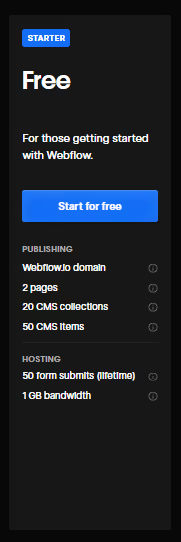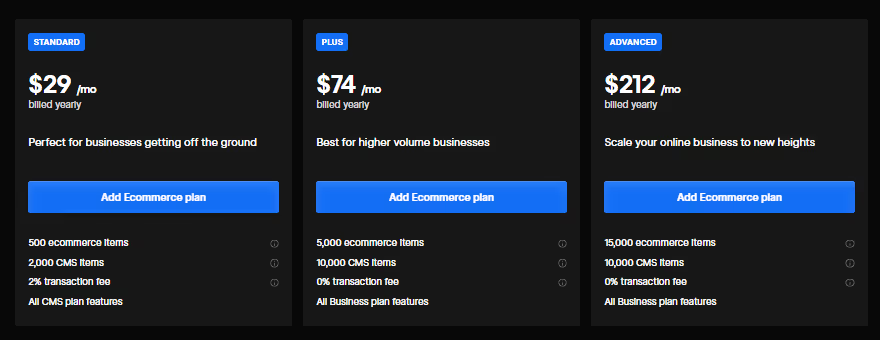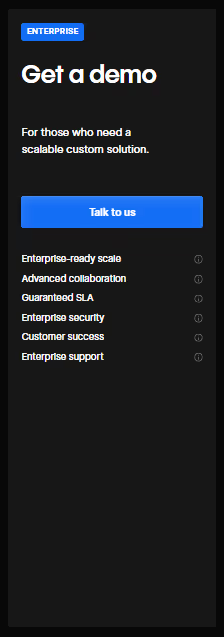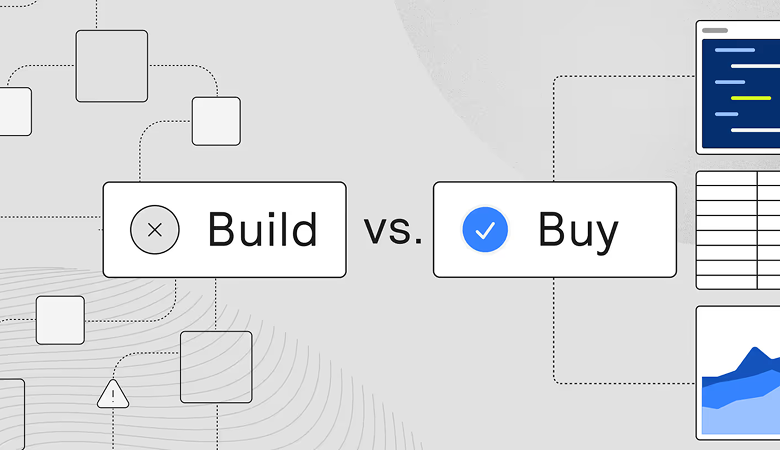Webflow is a visual development platform for building, hosting, and updating websites using a designer-friendly workflow. It combines a CMS, e-commerce, and collaboration features with hosting on Webflow’s infrastructure.
Webflow prices for each plan range from $14/month (Basic) to $212/month (Advanced e-commerce) when billed yearly. Workspace plans (Freelancer, Core, Growth, Agency) include 1 full seat in the plan price ($16 for Freelancer, $19 for Core, $49 for Growth, $35 for Agency, billed yearly).
Additional seats have separate fees: Full seats cost $39/seat/month, and Limited seats cost $15/seat/month (both billed yearly).
Note: If the plan grid changes, that may reflect new pricing from Webflow. Always check the official page to be sure of the latest costs.
Webflow features and pricing breakdown
This section covers the Webflow website builder’s features.
Webflow plans and pricing are built around two main types of plans: Site plans (for hosting websites) and Workspace plans (for collaboration and design). If you are comparing Webflow hosting plans, think of the Site plans as the hosting tiers (Basic, CMS, Business, e-commerce).
Below is Webflow pricing explained, plan by plan.
Webflow Free plan

Free Webflow plan with 2 pages, 50 CMS items, Webflow.io domain, and 1GB bandwidth that makes prototype creation easier.
Price: $0/month
Hosting: Only on Webflow.io subdomain
Usage caps: 2 static pages, 1 GB bandwidth, 50 CMS items
Webflow’s free plan is an entry point for experimenting with the platform before paying, not a Webflow free trial. It comes with basic hosting and lets users build and publish a site on a Webflow-branded subdomain.
Included:
- 2-page limit
- 1 GB/month bandwidth
- 50 CMS items
- Webflow.io domain
- Free access to Designer (Editor seats aren’t included on the free Starter site plan; “legacy Editor users” begin on CMS and Business site plans.)
Webflow Basic plan

Basic Webflow site plan at $14/month, includes 150 pages, 10GB bandwidth, and a custom domain.
Price: $14/month (annual) or $18/month (monthly)
Usage caps: 150 static pages, 10 GB bandwidth
Plan type: Site plan (per site)
The Basic plan is the first paid tier in Webflow site plans, ideal for small static websites that don’t need CMS or dynamic content. It gives users more flexibility than the free tier while keeping costs low.
Included:
- Custom domain support with SSL
- Up to 150 static pages
- 10 GB/month bandwidth
- Unlimited form submissions
- Basic SEO settings and custom code injection
Webflow CMS plan

CMS plan at $23/month with 2,000 CMS items, site search, 50 GB bandwidth, and support for 3 editor users.
Price: $23/month (annual) or $29/month (monthly)
Usage caps: 2,000 CMS items, 50 GB bandwidth, 3 editors
Plan type: Site plan (per site)
The Webflow CMS plan offers a full-featured content management system with dynamic templates. It unlocks collection lists, blog-style content workflows, and editor access.
Included:
- Up to 2,000 CMS items and 20 collections
- 50 GB/month bandwidth
- Site search feature
- 3 content editors via Webflow Editor
- Custom domain + SSL hosting
- 150 static pages
Webflow Business plan

Business site plan at $39/month, offering 300 pages, 10,000 CMS items, form file upload, and 100 GB bandwidth.
Price: $39/month (annual) or $49/month (monthly)
Usage-based pricing: Add-ons available for bandwidth and CMS item increases
Plan type: Site plan
The Webflow Business Plan adds more room to grow. It builds on the CMS tier and supports higher traffic, more content, and better control.
Webflow business plan features Included:
- 10,000 CMS items (expandable to 20,000 with paid add-ons)
- 100 GB bandwidth, with paid add‑ons up to +2.4 TB (total up to 2.5 TB)
- File upload support in forms
- 10 legacy Editor users
- 300 static pages
- Advanced search indexing and forms
Webflow e-commerce plans (Standard, Plus, Advanced)

Webflow e-commerce pricing tiers range from $29 to $212/month, comparing product limits, CMS caps, and transaction fees across Standard, Plus, and Advanced plans.
The price range goes as follows:
- Standard: $29/month (annual); up to 500 products, 2% Webflow transaction fee
- Plus: $74/month (annual); up to 5,000 products, 0% transaction fee, $200k/year sales cap
- Advanced: $212/month (annual); 15,000 products, no sales cap
Webflow e-commerce plans can help with selling physical and digital products. These tiers include everything from the CMS and Business plans, plus e-commerce tools like shopping carts, checkout flows, and sales analytics.
Included:
- Product and inventory management
- Stripe and PayPal integration
- CMS and content features
- Custom checkout styling
Webflow Workspace plans (Freelancer, Agency, Core, Growth)
Webflow Workspace pricing includes 1 full seat with the plan; additional seats are billed separately (Full $39/seat/month, Limited $15/seat/month, billed yearly).
Features vary by role type (freelancer vs in-house), but generally include:
- Guest access to projects
- Shared Libraries (Freelancer 1, Core 1, Growth 1, Agency unlimited)
- Staging (Core: 10 staged sites; Growth/Agency: unlimited)
- Advanced collaboration on Growth/Agency (site‑specific access, site‑level roles, publishing permissions)
Webflow Enterprise plan

Enterprise Webflow plan with custom pricing, offering scalable infrastructure, advanced collaboration, SLA guarantees, security, and dedicated support.
Price: Custom (Webflow enterprise pricing isn’t published).
Plan type: Both site and workspace contracts
Limits: Shown as Custom rather than “unlimited” (bandwidth, CMS items, and seats are tailored per contract)
The Webflow Enterprise plan is a custom agreement for businesses needing high performance, support, and control. It removes most platform limits and includes security and compliance features.
Included:
- Limits are custom (bandwidth, CMS items, and seats are set per contract)
- SSO, audit logs, and custom roles
- Guaranteed uptime (SLA)
- Priority technical support
- Dedicated account team
Remember: Pricing, plans, and features are subject to change. For the most up-to-date information, always refer to Webflow’s pricing page.
A closer look at Webflow’s usage-based pricing
Webflow pricing includes usage-based elements for bandwidth and CMS items, especially on the Business plan, which offers optional add‑ons for bandwidth and CMS items and a usage dashboard to help teams track consumption and decide when to add capacity.
Webflow Cloud is a website building and hosting platform offering usage-based pricing for bandwidth and CMS items. The Business plan includes optional add-ons with usage dashboards for tracking consumption. Surge protection handles traffic spikes, and sites auto-upgrade after two consecutive months above limits.
For Webflow Cloud pricing, usage-based elements like the bandwidth and CMS items drive hosting costs so that you pay for actual consumption, not overprovisioned resources. Webflow Cloud is available on all the Webflow site plans, and the features and limits vary according to your plan.
Let’s zoom in on Webflow’s usage-based elements.
What counts as usage?
Webflow tracks three main variables that affect pricing:
- Bandwidth (monthly traffic)
- CMS items (content database entries)
- Form submissions (limited only on the free plan)
Each site plan comes with fixed limits. If users go over, Webflow will prompt an upgrade or offer add-ons, depending on their tier.
CMS item limits and charges
Each CMS item is a record in the user site’s database: blog posts, products, events, etc. Plans include:
- 2,000 CMS items
- 10,000 on Business
Business plan users can increase CMS items via add-ons:
- +5,000 items: $25/month
- +10,000 items: $50/month
- Max: 20,000 items on Business
There are no automatic overages here. When you reach CMS limits, Webflow prompts you to upgrade or add capacity so that you can keep publishing without interruptions.
Note: If you’re exploring pricing strategy frameworks, see our guides on pricing and packaging strategy, pricing models for products, and tiered pricing examples.
Why do companies like Webflow adopt usage-based billing?
Platforms with variable workloads often align pricing to the resources customers consume. When traffic, content volume, or operational activity fluctuates, usage-based components help:
- Match price to value delivered: Costs track with how much a customer uses resource-intensive capabilities.
- Support diverse profiles: Light and heavy users can coexist under the same product without one subsidizing the other.
- Scale smoothly: As projects grow, billing scales with them; no custom engineering required to keep invoices accurate.
- Improve transparency: Clear measurements of usage and entitlements make it easier to understand the bill-calculation process.
Note: For deeper primers, see subscription billing and pricing models for products.
Why is usage-based billing becoming the default?
Across SaaS, AI, and cloud infrastructure, teams adopt usage-based pricing because it aligns spend with consumption, protects margins as workloads grow, and supports different customer profiles within one platform.
Align price with cost and value
Customers pay in proportion to how much they use resource-intensive capabilities. Invoices reflect activity rather than broad tiers alone.
- How it works: Specific units (for example, requests, bandwidth, items, seats, or minutes) roll up into clear line items. Included amounts cover baseline needs. Additional units are billed at the defined rate.
- What it looks like: Thresholds or credits establish headroom for typical usage. When activity increases, charges increase in a transparent way. Finance can tie each line item to the underlying usage for easy review.
Protect margins at scale
Unit economics stay healthy as workloads grow. Pricing reflects the real drivers of cost.
- How it works: Each plan includes a set amount of usage (the entitlement). Once a customer goes beyond that included capacity, extra usage is billed at the defined rate.
Minimum charges and credits create a stable baseline, so invoices remain predictable even as usage fluctuates.
- What it looks like: Accounts with heavier usage pay more, in line with the resources they consume. Finance teams can review margins for each type of usage (such as bandwidth, items, or requests) and adjust thresholds or rates to stay aligned with revenue targets.
Serve multiple segments from one product
Light and heavy users adopt the same platform and scale at their own pace. Entry stays simple while supporting growth.
- How it works: Tiered plans cover core needs for their target audience. Add-ons and higher limits expand capacity without custom contracts. Enterprise options layer in security and SLA.
- What it looks like: A small team starts with included usage. As activity grows, they add capacity or move to a higher tier. One catalog supports self-serve, sales-assisted, and enterprise motions.
Note: For more depth, see pricing and packaging, tiered examples, and versions and migrations.
FAQs
Is there an easy guide on how to understand Webflow pricing?
Yes. A good rule of thumb to understand Webflow pricing is that most websites need a CMS plan ($23/month billed annually), while teams need a workspace plan starting at $16/month per seat. You can explore pricing scenarios using Webflow’s official site plans page.
Please note that many people use both a workspace plan for design/collaboration and a site plan for hosting to run their website.
Do I need coding for Webflow?
You don’t need to write code to build and publish in Webflow. The platform generates clean HTML/CSS/JS from a visual canvas. Custom code is optional if you want advanced behaviors.
What’s the web design services pricing for Webflow?
Webflow doesn’t offer design services directly; it’s a self-serve platform. However, freelancers and agencies listed in the Webflow Partners directory may charge anywhere from $500 to $10,000+, depending on project scope. Providers set their pricing independently.
Can I host my own Webflow site?
Yes, you can host your own Webflow site for static sites. On a paid Workspace plan, you can export code (HTML/CSS/JS/assets) and host it anywhere. Note that dynamic features (CMS items/pages, forms, search, ecommerce, user accounts) don’t export and require Webflow hosting to function.
Learn how Orb supports usage-based billing
Webflow has shown how powerful a hybrid pricing model can be with fixed tiers combined with usage-based add-ons. But building that pricing architecture from scratch takes serious engineering effort and ongoing maintenance.
That’s where Orb comes in.
Orb is the pricing and billing infrastructure that powers usage-based, tiered, hybrid, and custom models, without locking you into static systems or restrictive pricing logic. Whether you're billing by volume, usage tiers, seats, or entitlements, the platform gives you the tools to launch, experiment, and adapt pricing strategies as fast as your business grows. Here’s how Orb supports dynamic pricing models:
- Test changes safely, before they go live: Use Orb Simulations to experiment with new pricing models, tiers, or usage thresholds using real usage data. Forecast revenue impact and customer response before making changes public.
- Define pricing logic without touching product code: Build and adjust pricing models using Orb SQL Editor or a visual editor. Define value metrics once, then reuse them across plans. No engineering needed.
- Adapt plans without engineering bottlenecks: Version your pricing plans, launch new tiers, or run billing experiments without deploying a new release. Orb supports plan versioning and feature gating out of the box.
- Send invoices customers understand: Orb generates transparent, auditable invoices that reflect real usage. Every line item can be traced back to event data, so your customers know what they’re paying for.
- Unify data across billing, reporting, and product: With Orb RevGraph, all usage events flow into one system, along with pricing and product data. Finance, product, and ops teams work from the same source of truth, reducing the amount of manual reconciliation.
- Scale pricing alongside your product: Whether you're selling to startups or enterprise clients, Orb makes it easy to build pricing models that evolve with user needs and product maturity.
Orb supports your team with billing expertise and ongoing partnership, which is especially important if you're launching usage-based pricing for the first time or migrating from rigid systems. Explore Orb’s flexible pricing tiers and discover how to build a pricing engine designed for growth.

.avif)

